2016 Honda Civic Sedan

WHAT WE LIKE: Continuously variable automatic transmissions have long been derided around here, but the tide is turning some, thanks to powertrains like the 1.5-liter turbo inline-four/CVT combination in our long-term Honda Civic. In fact, this torque-rich drivetrain has earned praise from several corners. Reviews editor Josh Jacquot proclaimed the Civic to be home to “one of the best CVT/four-cylinder combos on the market today,” while testing director Don Sherman said that “this transmission’s pluses—instantaneous power surges for passing and smooth, shiftless operation—far outweigh its minuses such as occasional high-rpm droning.”
The small-displacement turbo four-cylinder also lives up to its billing by delivering consistently stellar fuel economy. Our average dipped a bit during the winter but still sits at a miserly 34 mpg overall, and we’ve seen tank-average fuel economy as high as 41 mpg on highway trips.
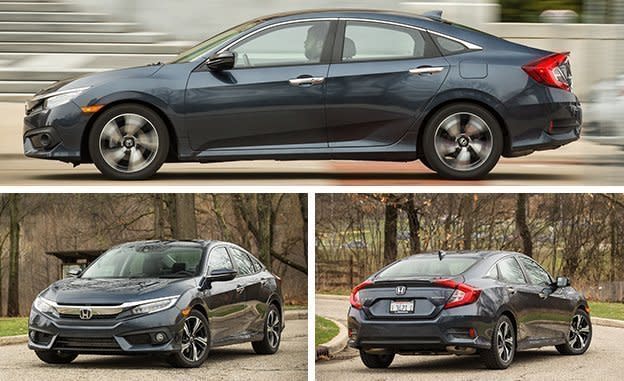
On a more frivolous note, we discovered a fun Easter egg inside of our Civic’s center console that’s sure to delight Honda fanatics. The underside of the rubber spill mat features an engraving showing vintage Honda race cars and the HondaJet—three other designs also exist with illustrations of various other bits of Honda motorsports history.
WHAT WE DON’T LIKE: Complaints continue to roll in concerning the lack of a proper volume knob, with one staffer calling it “a huge functionality oversight.” Honda has since realized its error and reinstalled the knob in the 2017 CR-V, but it likely won’t reappear in the Civic until the car gets a mid-cycle refresh. Until then, we’re stuck with the finicky volume slider on the dash or the steering-wheel volume switch, which also incorporates a touch-sensitive slider that some of us like and some of us hate.
Speaking of volume, long-distance travelers have been annoyed with the amount of road noise at highway speeds. Some thought the Bridgestone Blizzak winter tires were to blame, although the complaints persisted even after we swapped back to the all-season Firestone FT140 rubber. The all-season tires did at least diminish the freeway wandering that some noted with the Blizzaks and their softer rubber compound.
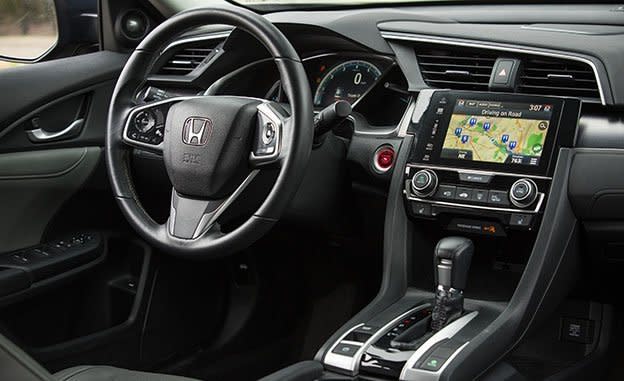
WHAT WENT WRONG: Our Civic’s sole issue was related to its infotainment system: The SiriusXM satellite-radio reception stopped. Our dealer reset the system for free, and all was well. Otherwise, the Civic has required only routine scheduled service just before 20,000 miles that included an oil change and a tire rotation for $69.
WHERE WE WENT: The Civic hasn’t ventured much beyond Michigan’s borders over the past few months, making a trip to Chicago but otherwise serving mostly as a commuter runabout in the greater Detroit area.
Months in Fleet: 8 months Current Mileage: 20,174 miles
Average Fuel Economy: 34 mpg Fuel Tank Size: 12.4 gal Fuel Range: 420 miles
Service: $133 Normal Wear: $0 Repair: $0
Specifications >
VEHICLE TYPE: front-engine, front-wheel-drive, 5-passenger, 4-door sedan
PRICE AS TESTED: $27,335 (base price: $19,475)
ENGINE TYPE: turbocharged and intercooled DOHC 16-valve inline-4, aluminum block and head, direct fuel injection
Displacement: 91 cu in, 1497 cc
Power: 174 hp @ 6000 rpm
Torque: 162 lb-ft @ 1700 rpm
TRANSMISSION: continuously variable automatic
DIMENSIONS:
Wheelbase: 106.3 in
Length: 182.3 in
Width: 70.8 in Height: 55.7 in
Passenger volume: 95 cu ft
Cargo volume: 15 cu ft
Curb weight: 2920 lb
PERFORMANCE: NEW
Zero to 60 mph: 6.9 sec
Zero to 100 mph: 17.5 sec
Zero to 120 mph: 28.5 sec
Rolling start, 5–60 mph: 7.5 sec
Top gear, 30–50 mph: 4.0 sec
Top gear, 50–70 mph: 4.9 sec
Standing ¼-mile: 15.3 sec @ 94 mph
Top speed (governor limited): 126 mph
Braking, 70–0 mph: 179 ft
Roadholding, 300-ft-dia skidpad: 0.83 g
FUEL ECONOMY:
EPA city/highway driving: 31/42 mpg
C/D observed: 34 mpg
Unscheduled oil additions: 0 qt
WARRANTY:
3 years/36,000 miles bumper to bumper;
5 years/60,000 miles powertrain;
5 years/unlimited miles corrosion protection;
3 years/36,000 miles roadside assistance
It's hard to believe, but it has been nearly two decades since we last conducted a long-term test of a Honda Civic. A 1997 Civic HX coupe was the most recent example of Honda’s venerable compact to go through our 40,000-mile test regimen. Now, almost 19 years and four Civic generations later, we’re finally welcoming another one into the fold: a 2016 sedan in top-of-the-line Touring trim.
Why is this 10th-generation Civic important enough to warrant an extended closer look? First, because it’s a shot at redemption for Honda. The ninth-gen Civic drew critical ire, mostly for its plain styling and lack of driving verve. Early indications, including a strong second-place finish in a recent five-car comparison test, are promising. The new Civic certainly can’t be called plain, no matter the body style—the coupe, hatchback, and sedan versions all display curves and angles that are daring for a Civic. And the new Civic is a big deal for Honda in a broader sense, because this car’s platform was engineered right here in the U.S.A. by Honda’s Marysville, Ohio, team and will form the basis for all global versions of the Civic. It also will underpin the next Accord mid-size sedan and CR-V crossover.
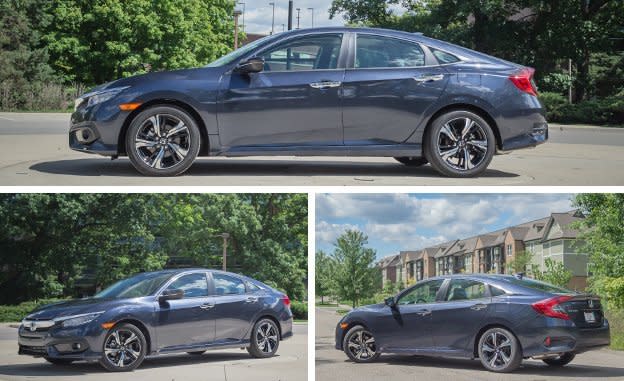
Loaded to the Gills
To sample the full palette of what the new Civic has to offer, we opted for the sedan’s top Touring trim level. That means getting as standard the new 174-hp 1.5-liter turbocharged four-cylinder, the first forced-induction engine installed in a U.S. Honda product since the original 2007 Acura RDX. A continuously variable automatic is the only transmission choice for 2016 turbo Civics—yes, a six-speed manual is coming for certain boosted 2017 models, but we figure most stick-shift enthusiasts will wait for the upcoming Civic Si. Plus, Honda has had plenty of time to get CVTs right: even our ’97 Civic HX long-termer had one as a nod to its high-fuel-economy mission.
That’s about where the similarities between 1997 and 2016 end, technology-wise. Our Civic Touring is positively chock-full of the latest equipment, including a 7.0-inch central touchscreen with Apple CarPlay/Android Auto capability, dual-zone automatic climate control, push-button start, and a digital gauge cluster with customizable information displays. Honda’s full package of active-safety features is standard on the Touring, comprising adaptive cruise control, lane-keeping assist, forward-collision warning, the proprietary LaneWatch camera (which displays a view of the passenger-side blind spot on the main screen when the right turn signal is engaged), and a few other systems to help avoid accidents. Shelling out for the Touring model also affords a few features not available on any other Civic trim level, notably LED headlights, rain-sensing wipers, heated rear seats, a power passenger seat, a 450-watt premium audio system, and slightly thicker front and rear anti-roll bars.
All told, our Civic Touring’s $27,335 price might seem steep for a compact Honda. But we will say that our long-term BMW 740i, costing more than three times as much, at $96,095, is missing some of the Civic’s key features such as adaptive cruise, Apple CarPlay/Android Auto, and remote start.
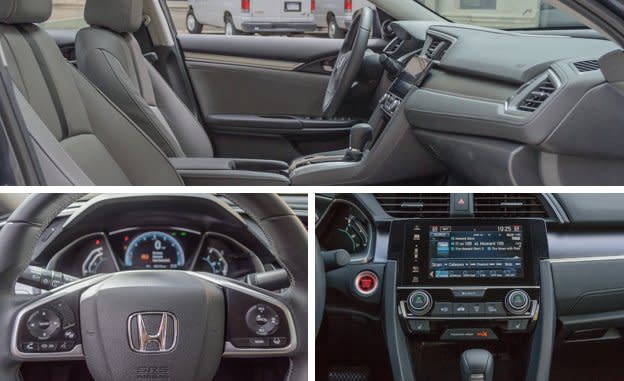
So Far, So Good
After a month of road tripping and commuting, we find that comments in the Civic’s logbook are mostly positive. The powertrain has proved especially impressive, averaging a stellar 39 mpg—a figure made all the more remarkable when you consider our car clocked a zero-to-60-mph time of 6.9 seconds. The sharp steering and composed ride quality also are strong points. Several complaints have arisen concerning the central touchscreen, which is frustrating to use—as is its slider to adjust audio volume—along with the herky-jerky nature of the adaptive cruise control. The latter system’s bad behavior spurred some drivers into deactivating the adaptive function in favor of good old regular cruise—a handy feature not always included with these systems. It’s achieved by holding down the button that adjusts the following distance.
So, yes, maybe some of the Civic’s advanced tech features spur more frustration than actual advancement, but we’ll see how our opinions evolve as we live with the car. We’re also curious to find out how the Honda’s impressive fuel economy holds up as weather conditions change and the leadfoots around here get more time behind the wheel. But considering our initial impression of all-around goodness, at this point we’ll simply say that, after nearly 20 years, it’s nice to have a Honda Civic back in our long-term stable.
Months in Fleet: 1 month Current Mileage: 2380 miles
Average Fuel Economy: 39 mpg Fuel Tank Size: 12.4 gal Fuel Range: 480 miles
Service: $0 Normal Wear: $0 Repair: $0
Specifications >
VEHICLE TYPE: front-engine, front-wheel-drive, 5-passenger, 4-door sedan
PRICE AS TESTED: $27,335 (base price: $27,335)
ENGINE TYPE: turbocharged and intercooled DOHC 16-valve inline-4, aluminum block and head, direct fuel injection
Displacement: 91 cu in, 1496 cc
Power: 174 hp @ 6000 rpm
Torque: 162 lb-ft @ 1700 rpm
TRANSMISSION: continuously variable automatic
DIMENSIONS:
Wheelbase: 106.3 in
Length: 182.3 in
Width: 70.8 in Height: 55.7 in
Passenger volume: 95 cu ft
Cargo volume: 15 cu ft
Curb weight: 2920 lb
PERFORMANCE: NEW
Zero to 60 mph: 6.9 sec
Zero to 100 mph: 17.5 sec
Zero to 120 mph: 28.5 sec
Rolling start, 5–60 mph: 7.5 sec
Top gear, 30–50 mph: 4.0 sec
Top gear, 50–70 mph: 4.9 sec
Standing ¼-mile: 15.3 sec @ 94 mph
Top speed (governor limited): 126 mph
Braking, 70–0 mph: 179 ft
Roadholding, 300-ft-dia skidpad: 0.83 g
FUEL ECONOMY:
EPA city/highway driving: 31/42 mpg
C/D observed: 39 mpg
Unscheduled oil additions: 0 qt
WARRANTY:
3 years/36,000 miles bumper to bumper;
5 years/60,000 miles powertrain;
5 years/unlimited miles corrosion protection;
3 years/36,000 miles roadside assistance
WHAT WE LIKE: After a few months of road-tripping, commuting, and tooling around in the 10th-generation Civic (a.k.a. Civic X), it’s clear that the new car’s chassis is a solid achievement on Honda’s part. Its dynamic fundamentals—things like going, stopping, and turning—are near the top of the compact class, with our editors praising the responsive steering, the composed ride quality, and the progressive feel of the brake pedal. Although the turbocharged 1.5-liter inline-four may not evoke high-revving fevered dreams as did the Honda VTEC four-bangers of yore, it delivers torque low down in the rev range, which mitigates our criticisms of the continuously variable automatic transmission. Several drivers proclaimed this Civic’s CVT to be among the best of its kind for the way it modulates torque smoothly and unobtrusively, rarely eliciting the loud moaning from the engine that often accompanies this transmission type. Additionally, the powertrain is delivering an impressive average of 35 mpg thus far.
WHAT WE DON’T LIKE: For a new-for-2016 compact car engineered with tech-savvy buyers in mind, the Civic’s touchscreen interface and its active-safety systems are disappointingly behind the times. The central infotainment screen has come under fire for slow operation and overly complex menu structures. Several complaints also arose about an overly sensitive forward-collision-warning system that sounds its alert at the merest suggestion of a possible impact—such as when a driver has already begun slowing using the brakes when approaching a stopped car. (There are three sensitivity settings for the forward-collision system, which we will continue to experiment with.)

We’re also not thrilled with the amount of noise from the Firestone FT140 tires that came installed on our car, as they generate a bothersome thrum when cruising on the freeway and loud thwaps when traversing expansion joints. We’d be more inclined to forgive these transgressions in return for more dry-weather grip, but they recorded only a modest 0.83 g in our skidpad test. To prepare our Civic for snow season, we fitted it with a set of Bridgestone Blizzak WS80 winter tires that, despite their more aggressive tread, counterintuitively seemed to reduce overall tire noise.
WHAT WENT WRONG: After a routine $64 oil and filter change and tire rotation at 9800 miles (and a recall fix for new stability-control software programming), we asked our dealer to take a look at an annoying rattle coming from the rear parcel shelf. The technician determined that the shelf was distorted, and it was replaced under warranty. The rattle, which had been most obvious when listening to music with heavy bass, appears to be gone for now. (Translation: It’s time to crank up the Kendrick Lamar.)
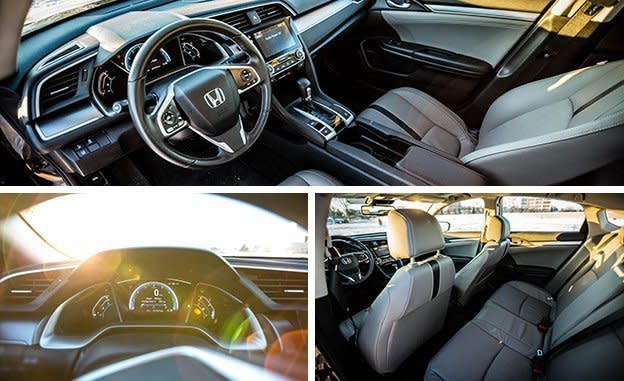
WHERE WE WENT: Although the Honda has been fulfilling its, ahem, civic duty as an efficient daily commuter, staffers aren’t shy to sign it out for road trips thanks to its comfortable seats and good fuel economy. It has already logged jaunts to Chicago, New York City, Louisville, Kentucky, and Columbus, Ohio, and has even ventured into the Great White North, rolling up miles during a trip into central Ontario.
Months in Fleet: 5 months Current Mileage: 11,034 miles
Average Fuel Economy: 35 mpg Fuel Tank Size: 12.4 gal Fuel Range: 430 miles
Service: $64 Normal Wear: $0 Repair: $0
Specifications >
VEHICLE TYPE: front-engine, front-wheel-drive, 5-passenger, 4-door sedan
PRICE AS TESTED: $27,335 (base price: $19,475)
ENGINE TYPE: turbocharged and intercooled DOHC 16-valve inline-4, aluminum block and head, direct fuel injection
Displacement: 91 cu in, 1497 cc
Power: 174 hp @ 6000 rpm
Torque: 162 lb-ft @ 1700 rpm
TRANSMISSION: continuously variable automatic
DIMENSIONS:
Wheelbase: 106.3 in
Length: 182.3 in
Width: 70.8 in Height: 55.7 in
Passenger volume: 95 cu ft
Cargo volume: 15 cu ft
Curb weight: 2920 lb
PERFORMANCE: NEW
Zero to 60 mph: 6.9 sec
Zero to 100 mph: 17.5 sec
Zero to 120 mph: 28.5 sec
Rolling start, 5–60 mph: 7.5 sec
Top gear, 30–50 mph: 4.0 sec
Top gear, 50–70 mph: 4.9 sec
Standing ¼-mile: 15.3 sec @ 94 mph
Top speed (governor limited): 126 mph
Braking, 70–0 mph: 179 ft
Roadholding, 300-ft-dia skidpad: 0.83 g
FUEL ECONOMY:
EPA city/highway driving: 31/42 mpg
C/D observed: 35 mpg
Unscheduled oil additions: 0 qt
WARRANTY:
3 years/36,000 miles bumper to bumper;
5 years/60,000 miles powertrain;
5 years/unlimited miles corrosion protection;
3 years/36,000 miles roadside assistance

